
David Chester Gibbons is an English comics artist, writer and sometimes letterer. He is best known for his collaborations with writer Alan Moore, which include the miniseries Watchmen and the Superman story "For the Man Who Has Everything". He was an artist for 2000 AD, for which he contributed a large body of work from its first issue in 1977.

John Wagner is an American-born British comics writer. Alongside Pat Mills, he helped revitalise British comics in the 1970s, and continues to be active in the British comics industry, occasionally also working in American comics. He is best known as the co-creator, with artist Carlos Ezquerra, of the character Judge Dredd.
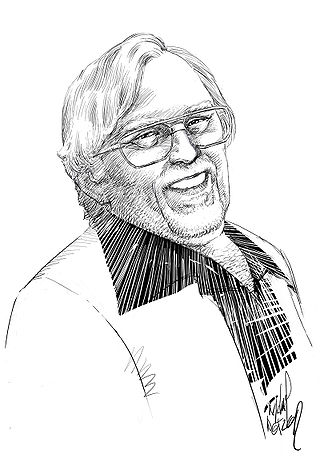
Richard Joseph Giordano was an American comics artist and editor whose career included introducing Charlton Comics' "Action Heroes" stable of superheroes and serving as executive editor of DC Comics.
First Comics was an American comic book publisher that was active from 1983 to 1991, known for titles like American Flagg!, Grimjack, Nexus, Badger, Dreadstar, and Jon Sable. Along with competitors like Pacific Comics and Eclipse Comics, First took early advantage of the growing direct market, attracting a number of writers and artists from DC and Marvel to produce creator-owned titles, which, as they were not subject to the Comics Code, were free to feature more mature content.
Shawn McManus is an American artist who has worked extensively over three decades for DC Comics and other companies, notably for DC's Vertigo imprint including the Fables series.

Mike Grell is an American comic book writer and artist, known for his work on books such as Green Lantern/Green Arrow, The Warlord, and Jon Sable Freelance.
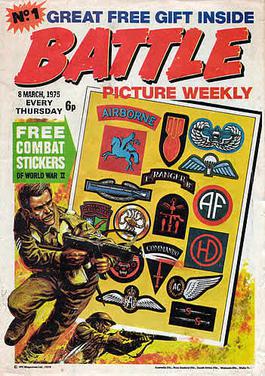
Battle Picture Weekly, at various times also known as Battle Action, Battle Action Force, Battle and Battle with Storm Force, was a British war comic book magazine published by IPC Magazines from 8 March 1975 to 23 January 1988, when it merged with the new incarnation of Eagle. Most stories were set in World War II, with some based on other conflicts.
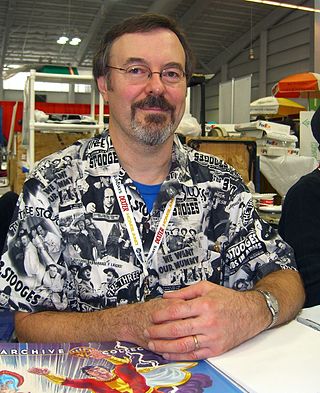
Jeremiah Ordway is an American writer, penciller, inker and painter of comic books.

Peter B. Gillis is an American comic book writer best known for his work at Marvel Comics and First Comics in the mid-1980s, including the series Strikeforce: Morituri and the digitally drawn comic series Shatter.
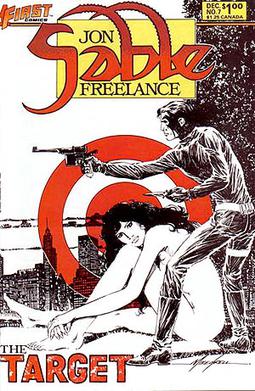
Jon Sable Freelance is an American comic book series, one of the first series created for the fledgling publisher First Comics in 1983. It was written and drawn by Mike Grell and was a fully creator-owned title. The comic was one of the first of the independent and dark superhero stories of the 1980s and "helped usher in the grim and gritty sensibility that came to define the genre. Beginning in November 2007, it was published as an online comic series by ComicMix.

Continuity Publishing, also known as Continuity Comics, was an American independent comic book company formed by Neal Adams in 1984, publishing comics until 1994.
In the United States, creator ownership in comics is an arrangement in which the comic book creator retains full ownership of the material, regardless of whether the work is self-published or published by a corporate publisher.

Denys B. Cowan is an American comics artist, television producer, media executive and one of the co-founders of Milestone Media.
Mike Saenz is an American comic book artist and software designer. He is the creator of Shatter, as well as an early adult video game, MacPlaymate. Saenz was also the founder of Reactor Inc., a defunct interactive game company.
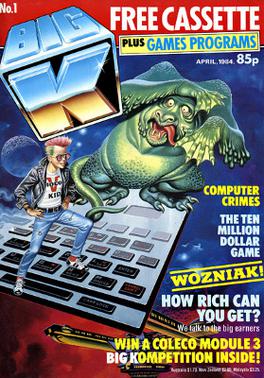
Big K was a short-lived multi format magazine published by IPC Magazines Ltd during the 1980s. The design of the magazine was very similar in style to their comic strip publications at the time, 2000ad and Roy of the Rovers and seemed to be aimed squarely at the younger computer user.
William C. Jaaska was an American comics artist.

M.A.S.K. is a media franchise created by Kenner. The main premise revolved around the fight between the titular protagonist underground task force and the criminal organization V.E.N.O.M.. After its initial launch in 1985, the franchise spawned a variety of products and presentations, including four series of action figures, an animated television series, video games, comics, and a live-action theatrical film is currently in development by Hasbro Studios and Paramount.
Howard Nicholas Bender is an American comic book artist best known for his work for DC Comics and Archie Comics.

Princess was a weekly British magazine for girls, published from 30 January 1960 to 16 September 1967 by Fleetway Publications. The publication featured a mix of articles, features, and comic strips.












